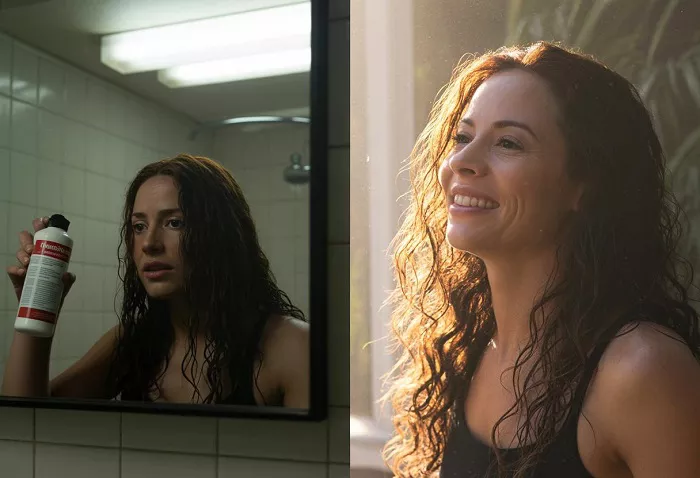When Emma tossed her shampoo bottle into the recycling bin and declared, “I’m done with chemicals,” it marked the start of a month-long experiment that would redefine her relationship with hair care. With the no-poo movement gaining popularity, Emma’s decision to forgo shampoo for 30 days seemed radical—until the results spoke for themselves.
The Rocky Start: Oil Overload
The first week without shampoo was a struggle. Emma’s fine hair turned greasy fast. “It feels like I’m wearing a helmet,” she confessed by day five. According to Dr. Lisa Henrikson, a dermatologist specializing in hair health advice, this greasy phase is a common reaction.
“When you stop using shampoo, your scalp compensates by overproducing oil because it’s used to being stripped clean,” she explains.
A Turning Point Around Day 12
By the second week, Emma noticed a shift. “My scalp doesn’t itch anymore,” she said, running her fingers through hair that looked healthier. Natural oils had begun to redistribute from the scalp to the ends—restoring moisture in a way commercial products often fail to mimic.
Holistic hair specialist Corinne Westfield notes, “Most people give up too early. It takes two to three weeks for the scalp to recalibrate its oil production and find balance.”
Volume Returns: Week Three Breakthrough
By day 21, Emma’s hair had transformed from flat and oily to voluminous and glossy. “It’s like my hair remembered how to be hair,” she joked. Research suggests that over-washing can damage the hair cuticle and strip proteins essential to strength and texture. With time, Emma’s natural hair structure returned—without the help of styling products.
What Happens When You Skip Shampoo?
According to experts, several biological shifts occur during a no-shampoo trial:
Sebaceous glands reduce oil production
The scalp’s natural microbiome rebalances
Hair cuticles remain intact, reducing breakage
The hair shaft retains its natural proteins
The Final Outcome: Simpler, Healthier, and Cheaper
After 30 days, Emma’s hair looked healthier than it had in years. Beyond the visual improvements, she had saved money, cut down on plastic waste, and simplified her routine. The transformation wasn’t just aesthetic—it was a complete lifestyle shift.
Gentle Alternatives That Worked
Emma didn’t abandon cleanliness. She relied on hair care tips like:
Apple cider vinegar rinses (1 tbsp per cup of water)
Occasional egg yolk treatments for deep cleansing
Thorough water-only rinses combined with scalp massages
These methods helped keep her scalp clean without disrupting its natural balance.
Is the No-Poo Method for Everyone?
Success with the no-poo approach varies by hair type. Those with curly or dry hair tend to adapt more easily, while individuals with fine, straight hair may struggle during the transition.
“The adjustment period is toughest for fine hair,” says Dr. Henrikson. “But even reducing shampoo frequency can offer benefits.”
The Nutrition Factor
Emma also noticed improvements after increasing omega-rich foods in her diet—reinforcing the idea that internal health reflects in your hair. Good nutrition, she found, plays a critical role in scalp balance and hair strength.
Rethinking Hair Care Norms
Emma’s journey echoes a larger movement toward holistic and sustainable personal care. What began as an experiment turned into a revelation: sometimes, the products we rely on are the very things keeping us from achieving optimal hair health.
In a world where traditional habits are constantly being challenged by new science and lived experiences, it may be time to reevaluate our hair care steps—and reconsider what “clean” really means.
Related Topics:
- How to Repair Heat Damaged Natural Hair Without Cutting It: Step-by-Step Guide
- How to Repair Damaged Relaxed Hair Without Cutting: Expert Tips
- How to Repair Damaged Natural Hair | No Cutting Required


